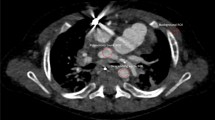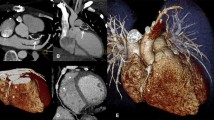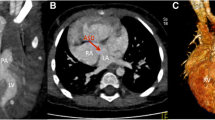Abstract
Cardiac CT angiography (cCTA) has become an established method for the assessment of congenital heart disease. However, the potential harmful effects of ionizing radiation must be considered, particularly in younger, more radiosensitive patients. In this study, we sought to assess the temporal change in radiation doses from pediatric cCTA during an 8-year period at a tertiary medical center. This retrospective study included all patients ≤18 years old who were referred to electrocardiography (ECG)-gated cCTA for the assessment of congenital heart disease or inflammatory disease (Kawasaki disease) from November 2004 to September 2012. During the study period, 95 patients were scanned using 3 different scanner models—64-slice multidetector CT (64-MDCT) and first- (64-DSCT) and second-generation (128-DSCT) dual-source CT—and 3 scan protocols—retrospective ECG-gated helical scanning (RG), prospective ECG-triggered axial scanning (PT), or prospective ECG-triggered high-pitch helical scanning (HPH). Effective dose (ED) was calculated with the dose length product method with a conversion factor (k) adjusted for age. ED was then compared among scan protocols. Image quality was extracted from clinical cCTA reports when available. Overall, 94 % of scans were diagnostic (80 % for 64-slice MDCT, 93 % for 64-slice DSCT, and 97 % for 128-slice DSCT).With 128-DSCT, median ED (1.0 [range 0.6–2.0] mSv) decreased by 85.8 % and 66.8 % compared with 64-MDCT (6.8 [range 2.9–13.6] mSv) and 64-DSCT (2.9 [range 0.9–4.1] mSv), respectively. With HPH, median ED (0.9 [range 0.6–1.8] mSv) decreased by 59.4 % and 85.4 % compared with PT (2.2 [range 0.9–3.4] mSv) and RG (6.1 [range 2.5–10.6] mSv). cCTA can now be obtained at very low radiation doses in pediatric patients using the latest dual-source CT technology in combination with prospective ECG-triggered HPH acquisition.






Similar content being viewed by others
References
Achenbach S, Marwan M, Schepis T, Pflederer T, Bruder H, Allmendinger T et al (2009) High-pitch spiral acquisition: a new scan mode for coronary CT angiography. J Cardiovasc Comput Tomogr 3(2):117–121
Achenbach S, Marwan M, Ropers D, Schepis T, Pflederer T, Anders K et al (2010) Coronary computed tomography angiography with a consistent dose below 1 mSv using prospectively electrocardiogram-triggered high-pitch spiral acquisition. Eur Heart J 31(3):340–346
Alkadhi H, Stolzmann P, Desbiolles L, Baumueller S, Goetti R, Plass A et al (2010) Low-dose, 128-slice, dual-source CT coronary angiography: accuracy and radiation dose of the high-pitch and the step-and-shoot mode. Heart 96(12):933–938
Al-Mousily F, Shifrin RY, Fricker FJ, Feranec N, Quinn NS, Chandran A (2011) Use of 320-detector computed tomographic angiography for infants and young children with congenital heart disease. Pediatr Cardiol 32(4):426–432
Araoz PA, Kirsch J, Primak AN, Braun NN, Saba O, Williamson EE et al (2010) Dual-source computed tomographic temporal resolution provides higher image quality than 64-detector temporal resolution at low heart rates. J Comput Assist Tomogr 34(1):64–69
Bean MJ, Pannu H, Fishman EK (2005) Three-dimensional computed tomographic imaging of complex congenital cardiovascular abnormalities. J Comput Assist Tomogr 29(6):721–724
Brady SL, Kaufman RA (2012) Investigation of American Association of Physicists in Medicine Report 204 size-specific dose estimates for pediatric CT implementation. Radiology 265(3):832–840
Brink JA, Morin RL (2012) Size-specific dose estimation for CT: how should it be used and what does it mean? Radiology 265(3):666–668
Bulas DI, Goske MJ, Applegate KE, Wood BP (2009) Image Gently: why we should talk to parents about CT in children. AJR Am J Roentgenol 192(5):1176–1178
Chan FP (2009) MR and CT imaging of the pediatric patient with structural heart disease. Semin Thorac Cardiovasc Surg Pediatr cardiac surg ann. doi:10.1053/j.pcsu.2009.01.009
Chodick G, Kim KP, Shwarz M, Horev G, Shalev V, Ron E (2009) Radiation risks from pediatric computed tomography scanning. Pediatr Endocrinol Rev 7(2):29–36
Christner JA, Braun NN, Jacobsen MC, Carter RE, Kofler JM, McCollough CH (2012) Size-specific dose estimates for adult patients at CT of the torso. Radiology 265(3):841–847
Colletti PM (2011) Image gently: go with the guidelines. Clin Nucl Med 36(12):e233–e235
Dauer LT, St Germain J, Meyers PA (2008) Let’s image gently: reducing excessive reliance on CT scans. Pediatr Blood Cancer 51(6):838 author reply 839–840
Deak PD, Smal Y, Kalender WA (2010) Multisection CT protocols: sex- and age-specific conversion factors used to determine effective dose from dose-length product. Radiology 257(1):158–166
Di Sessa TG, Di Sessa P, Gregory B, Vranicar M (2009) The use of 3D contrast-enhanced CT reconstructions to project images of vascular rings and coarctation of the aorta. Echocardiography 26(1):76–81
Don S, Goske MJ, John S, Whiting B, Willis CE (2011) Image gently pediatric digital radiography summit: executive summary. Pediatr Radiol 41(5):562–565
Engel LC, Ferencik M, Liew GY, Karolyi M, Sidhu MS et al (2012) Ultra-low dose cardiac CT angiography at 80 kV using second generation dual-source CT: assessment of radiation dose and image quality. J Med Diagn Methods 1:104
Etzel-Hardman D (2012) A call to “image gently.”. J Pediatr Nurs 27(4):428–429
Flohr TG, Leng S, Yu L, Aiimendinger T, Bruder H, Petersilka M et al (2009) Dual-source spiral CT with pitch up to 3.2 and 75 ms temporal resolution: image reconstruction and assessment of image quality. Med Phys 36(12):5641–5653
Furqan M, Haque A (2009) Surface area in children: a simple formula. Indian Pediatr 46(12):1085–1087
Ghoshhajra BB, Engel LC, Major GP, Goehler A, Techasith T, Verdini D, et al. (2012) Evolution of coronary computed tomography radiation dose reduction at a tertiary referral center. Am J Med 125(8):764–772]
Ghoshhajra BB, Engel LC, Karolyi M, Sidhu MS, Wai B, Barreto M et al (2012) Cardiac computed tomography angiography with automatic tube potential selection: Effects on radiation dose and image quality. J Thorac Imag 28(1):40–48
Goske MJ, Applegate KE, Boylan J, Butler PF, Callahan MJ, Coley BD et al (2008) The image gently campaign: working together to change practice. AJR Am J Roentgenol 190(2):273–274
Goske MJ, Frush DP, Schauer DA (2009) Image gently campaign promotes radiation protection for children. Radiat Prot Dosimetry 135(4):276
Goske MJ, Charkot E, Herrmann T, John SD, Mills TT, Morrison G et al (2011) Image gently: challenges for radiologic technologists when performing digital radiography in children. Pediatr Radiol 41(5):611–619
Goske MJ, Applegate KE, Bulas D, Butler PF, Callahan MJ, Coley BD et al (2011) Image gently: progress and challenges in CT education and advocacy. Pediatr Radiol 2:461–466
Goske MJ, Applegate KE, Bulas D, Butler PF, Callahan MJ, Don S et al (2012) Image gently 5 years later: what goals remain to be accomplished in radiation protection for children? AJR Am J Roentgenol 199(3):477–479
Halliburton SS, Abbara S, Chen MY, Gentry R, Mahesh M, Raff GL et al (2011) SCCT guidelines on radiation dose and dose-optimization strategies in cardiovascular CT. J Cardiovasc Comput Tomogr 5(4):198–224
Han BK, Lindberg J, Grant K, Schwartz RS, Lesser JR (2011) Accuracy and safety of high pitch computed tomography imaging in young children with complex congenital heart disease. Am J Cardiol 107(10):1541–1546
Han BK, Lindberg J, Overman D, Schwartz RS, Grant K, Lesser JR (2012) Safety and accuracy of dual-source coronary computed tomography angiography in the pediatric population. J Cardiovasc Comput Tomogr 6(4):252–259
Hausleiter J, Martinoff S, Hadamitzky M, Martuscelli E, Pschierer I, Feuchtner GM et al (2010) Image quality and radiation exposure with a low tube voltage protocol for coronary CT angiography results of the PROTECTION II Trial. JACC Cardiovasc Imag 3(11):1113–1123
Hirsch R, Gottliebson W, Crotty E, Fleck R, Strife J (2006) Computed tomography angiography with three-dimensional reconstruction for pulmonary venous definition in high-risk infants with congenital heart disease. Congenit Heart Dis 1(3):104–110
Hlavacek AM, Baker GH, Shirali GS (2009) Innovation in three-dimensional echocardiography and cardiac computed tomographic angiography. Cardiol Young 19(Suppl 2):35–42
Jhang WK, Park JJ, Seo DM, Goo HW, Gwak M (2008) Perioperative evaluation of airways in patients with arch obstruction and intracardiac defects. Ann Thorac Surg 85(5):1753–1758
Kilner PJ (2011) The role of cardiovascular magnetic resonance in adults with congenital heart disease. Prog Cardiovasc Dis 54(3):295–304
Lee AM, Engel LC, Shah B, Liew G, Sidhu MS, Kalra M et al (2012) Coronary computed tomography angiography during arrhythmia: Radiation dose reduction with prospectively ECG-triggered axial and retrospectively ECG-gated helical 128-slice dual-source CT. J Cardiovasc Comput Tomogr 6(3):172–183
Leschka S, Stolzmann P, Desbiolles L, Baumueller S, Goetti R, Schertler T et al (2009) Diagnostic accuracy of high-pitch dual-source CT for the assessment of coronary stenoses: first experience. Eur Radiol 19(12):2896–2903
Maruyama T, Takada M, Hasuike T, Yoshikawa A, Namimatsu E, Yoshizumi T (2008) Radiation dose reduction and coronary assessability of prospective electrocardiogram-gated computed tomography coronary angiography: comparison with retrospective electrocardiogram-gated helical scan. J Am Coll Cardiol 52(18):1450–1455
Moore QT, Don S, Goske MJ, Strauss KJ, Cohen M, Herrmann T et al (2012) Image Gently: using exposure indicators to improve pediatric digital radiography. Radiol Technol 84(1):93–99
Ntsinjana HN, Hughes ML, Taylor AM (2011) The role of cardiovascular magnetic resonance in pediatric congenital heart disease. J Cardiovasc Magn Reson 13:51
Oh KH, Choo KS, Lim SJ, Lee HD, Park JA, Jo MJ et al (2009) Multidetector CT evaluation of total anomalous pulmonary venous connections: comparison with echocardiography. Pediatr Radiol 39(9):950–954
Scheffel H, Alkadhi H, Leschka S, Plass A, Desbiolles L, Guber I et al (2008) Low-dose CT coronary angiography in the step-and-shoot mode: diagnostic performance. Heart 94(9):1132–1137
Sigal-Cinqualbre A, Lambert V, Ronhean A, Paul JF (2011) Role of MSCT and MRI in the diagnosis of congenital heart disease. Arch Pediatr. doi:10.1016/j.arcped.2011.02.00110.1016/j.arcped.2011.02.001
Siripornpitak S, Pornkul R, Khowsathit P, Layangool T, Promphan W, Pongpanich B (2011) Cardiac CT angiography in children with congenital heart disease. Eur J Radiol 82(7):1067–1082
Sorantin E, Riccabona M, Stucklschweiger G, Guss H, Fotter R (2012) Experience with volumetric (320 rows) pediatric CT. Eur J Radiol 5:5
Stolzmann P, Leschka S, Scheffel H, Krauss T, Desbiolles L, Plass A et al (2008) Dual-source CT in step-and-shoot mode: noninvasive coronary angiography with low radiation dose. Radiology 249(1):71–80
Strauss KJ, Goske MJ, Frush DP, Butler PF, Morrison G (2009) Image Gently Vendor Summit: working together for better estimates of pediatric radiation dose from CT. AJR Am J Roentgenol 192(5):1169–1175
Strauss KJ, Butler PF, Goske MJ, Ritenour ER (2009) Image gently: reducing radiation dose in pediatric computed tomography through collaboration. Med Phys 36(12):5719–5720
Strauss KJ, Goske MJ, Kaste SC, Bulas D, Frush DP, Butler P et al (2010) Image gently: ten steps you can take to optimize image quality and lower CT dose for pediatric patients. AJR Am J Roentgenol 194(4):868–873
Watson TG, Mah E, Joseph Schoepf U, King L, Huda W, Hlavacek AM (2012) Effective radiation dose in computed tomographic angiography of the chest and diagnostic cardiac catheterization in pediatric patients. Pediatr Cardiol 34(3):518–524
Westra SJ, Hill JA, Alejos JC, Galindo A, Boechat MI, Laks H (1999) Three-dimensional helical CT of pulmonary arteries in infants and children with congenital heart disease. AJR Am J Roentgenol 173(1):109–115
Author information
Authors and Affiliations
Corresponding author
Rights and permissions
About this article
Cite this article
Ghoshhajra, B.B., Lee, A.M., Engel, LC. et al. Radiation Dose Reduction in Pediatric Cardiac Computed Tomography: Experience from a Tertiary Medical Center. Pediatr Cardiol 35, 171–179 (2014). https://doi.org/10.1007/s00246-013-0758-5
Received:
Accepted:
Published:
Issue Date:
DOI: https://doi.org/10.1007/s00246-013-0758-5




